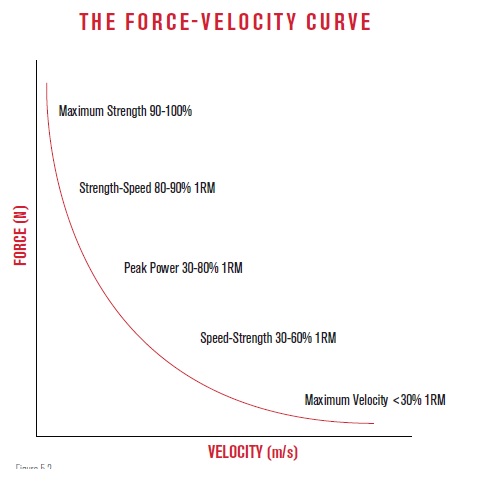So you want to become a better MMA fighter? Or maybe you want to know what it takes to become a professional fighter. These strength standards for MMA will give you the bench mark to get there.
While the technical skill aspect of MMA is the most important factor in MMA fight performance, having the physical qualities to back those skills up will go a long way to creating an unstoppable athlete.
Professional MMA fighters should have a Reactive Strength Index >2.6, be able to Isometric Mid-Thigh Pull >3.5x bodyweight as a test of maximal strength, and vertical jump >50cm. However, these values will differ between weight classes and gender. For example, female featherweights benchmark for maximal strength is only >2.5x bodyweight.
These values are taken as a broad overview from every weight class. But you are better off comparing your own strength to professional MMA fighters in your own weight class. That way you can get an accurate representation of your strength standards.
Why Is Strength Important In MMA?
Strength is an important quality in MMA as 77% of all UFC fights are ended during an 8-14 sec window of high-intensity activity. This high-intensity window is where the athlete can express their explosive strength and power capabilities. The greater these are, the greater chance of finishing the fight not accounting for the technical capabilities.

How to Dominate Every Fight with Raw, Explosive Power No One Can Match
Discover the underground blueprint that has quietly turned MMA hopefuls into legends, using nothing but sheer, brute force and bulletproof conditioning techniques.
Strength is often expressed as how much you can lift. This is defined as maximal strength. However, this isn’t the only way to test maximal strength. Further, there are other types of strength that are just as important to MMA performance. These being related to the force-velocity curve.
The force-velocity curve shows the inverse relationship between force and velocity. That is, the heavier the load being lifted, the slower the lift will be. And vice versa. Put very simply, you have fast and slow strength that can be trained.
This is important to know as the adaptations when lifting something heavy and slow and the adaptations when lifting something light and fast are different. So much so they could be seen as polar opposites.
One example is the shift in muscle fiber type. Heavy lifting shifts the fastest twitch Type IIX muscle fiber to not as fast-twitch Type IIA muscle fiber. In doing so, the oxidative capacity of the fast-twitch muscle fibers increases meaning they are more resistant to fatigue. However, the trade-off is a slower contraction.
High-velocity training on the other hand (the other end of the force-velocity curve) increases the proportion of the fastest twitch Type IIX muscle fibers. Meaning the enhancement in the speed of movement with the trade-off of fatiguing much faster.
This is the delicate balancing act of strength training for MMA. Spend too much time at either end (or not enough time addressing what you need along the force-velocity spectrum) and your physical performance may not be optimized.
That is why the UFCPI created a book called “A Cross-Sectional Performance Analysis And Projection Of The UFC Athlete” using a range of tests to quantify these strength capacities along the force-velocity curve.
Many of the tests I’m about to present require expensive sport science equipment and some knowledge on how to test and interpret the data. For that reason, I will either provide some alternatives or some harder to collect data won’t be presented.
If you want to read the full report, you can click on the hyperlink above.
How Do You Compare To The Pros?
Reactive Strength
We are going to start at the velocity end of the force-velocity curve with the Reactive Strength Index (RSI). If you are not familiar with this, RSI is considered a measure of explosiveness by measuring the ability to quickly transition from an eccentric contraction (downward phase of movement) to a concentric contraction (upward phase of the movement).
It is tested by dropping off of a box, landing on the ground, and immediately jumping as high as you can while spending the least amount of time on the ground as possible. The calculation is simply the height jumped divided by the ground contact time [1].
This requires a piece of equipment such as a jump mat to calculate ground contact time. However, the app My Jump 2 is the perfect, low-cost alternative anyone can use to measure this.
In MMA terms, the RSI determines how quickly you’re able to exert a maximal amount of force in minimal time against your own bodyweight. For example, changing direction to work new angles or throwing multiple punch combinations in quick succession.
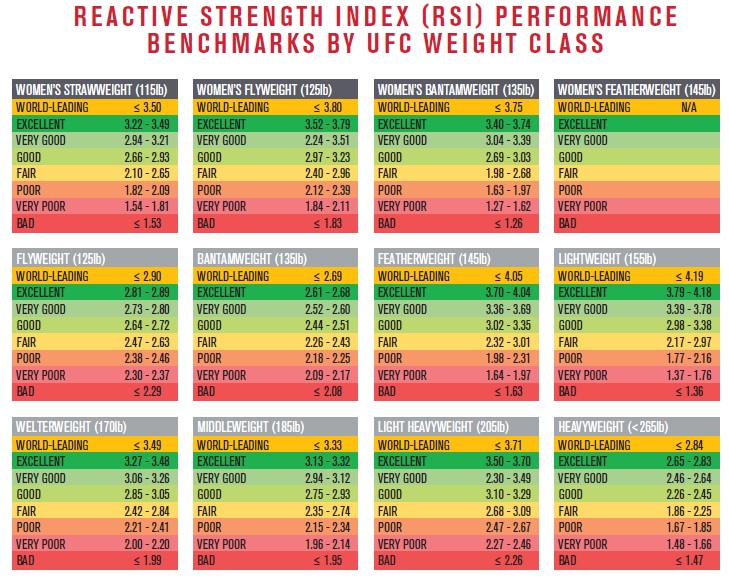
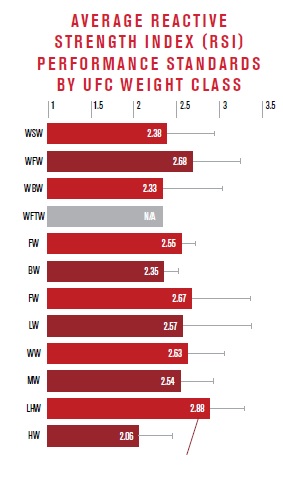
This specific test was performed off of a 40cm box so this can easily be replicated. To briefly explain the colors, being ‘good,’ ‘fair,’ or ‘poor,’ puts you within 68% of the professional fighter population.
As results start to move outside of these colors, ‘very poor’ to ‘excellent,’ you’re within 95% of the professional fighter population. Once you’re outside of these standards, you’re either world-class in the top 2.5% of all professional fighters or the bottom 2.5%.
Light heavyweights have the highest average RSI while women’s featherweight have the highest RSI among the females. If your RSI falls into a category ‘fair’ or below, you may consider improving this metric in your training. By performing more quick response plyometrics (e.g. pogo jumps, drop jumps, hurdle hops), you’ll develop reactive strength.
Elastic Strength
Elastic strength is measured by using the countermovement jump (CMJ), aka the vertical jump. While RSI measures a very fast transition between eccentric and concentric contractions (generally <250ms ground contact time), CMJ is considered a slower transition. However, this doesn’t make elastic strength any less important.
Elastic strength is directly related to peak power where force is multiplied by velocity. The harder and faster you can hit, the more devastating the strike or takedown will be. Think shooting for a double leg or throwing a flying knee.
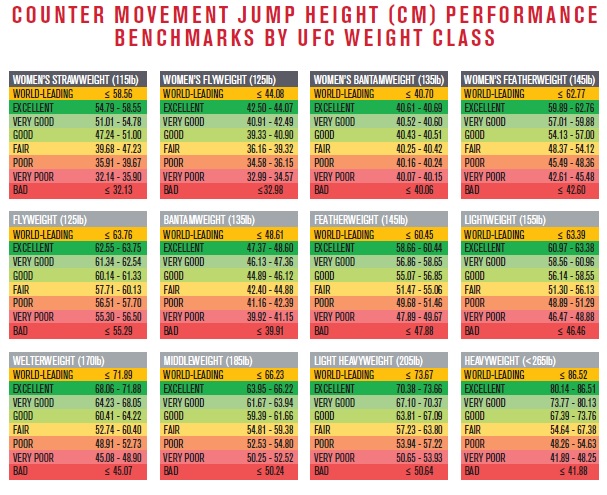
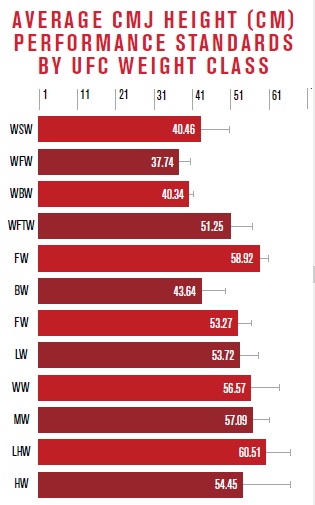
Light heavyweights again knock this one out of the park with their average jump height. These were likely performed with their hands on their hips to remove the contribution from the arms.
If you don’t have the equipment to test this, the My Jump 2 app can do this through your phone. If you’re lacking in this area (generally under a 50cm jump), then developing your elastic strength may be a priority. Various jump exercises can be used such as box jumps, broad jumps, and repeated jumps.
This has since been updated in 2021 in the new UFC PI Cross-Sectional Analysis.
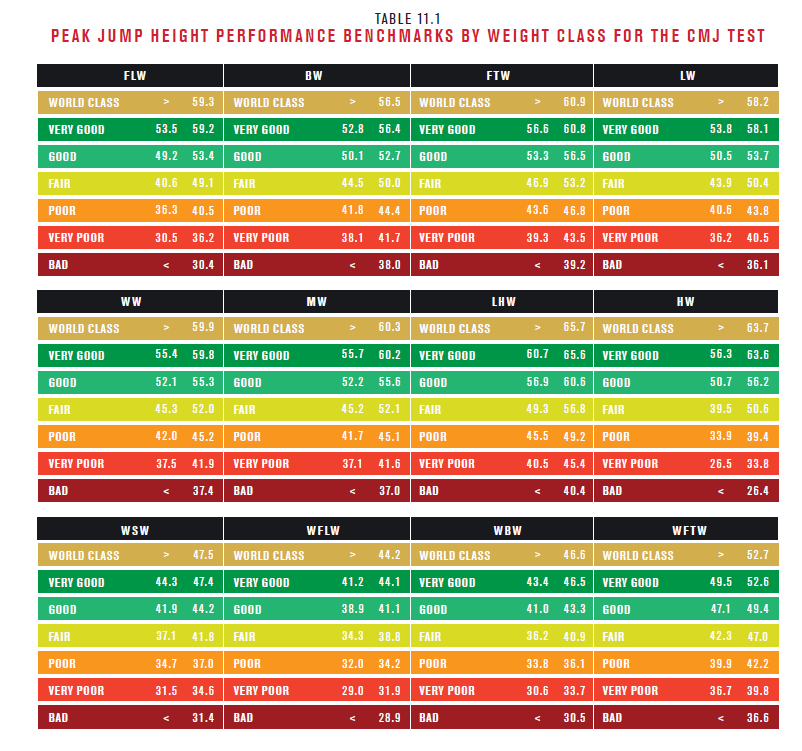
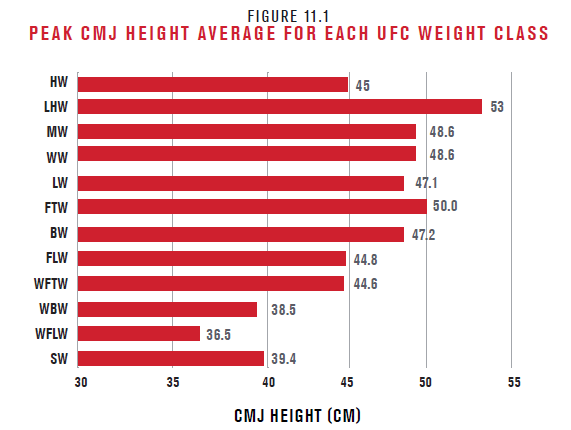
Overall, we can actually see the average countermovement jump height (vertical jump) has decreased from the release in 2018 of the UFC Performance Institutes analysis compared to the 2021 release. The world standard in some weight classes has been reduced such as the flyweight and lightweight category while others have increased such as the bantamweight and light heavyweight weight classes.
It’s difficult to speculate why there is an overall trend in a reduction of CMJ height. It is most likely to do with now having a larger or different sample of MMA athletes to test.
Maximal Strength
Think of maximal strength as your engine. If your engine can only accelerate your car to a maximum of 100 miles/h, while another athlete’s engine can get them to 150 miles/h, the bigger engine likely accelerates faster. They would also have the potential to produce more power by increasing the force side of the power equation (force x velocity).
Maximal strength was assessed using the isometric mid-thigh pull (IMTP). This is performed against an immovable bar (e.g. barbell being pulled against the pins) from a similar position as you would perform the rack pull. Standing on a force plate, athletes would pull as hard as possible for 6 seconds.
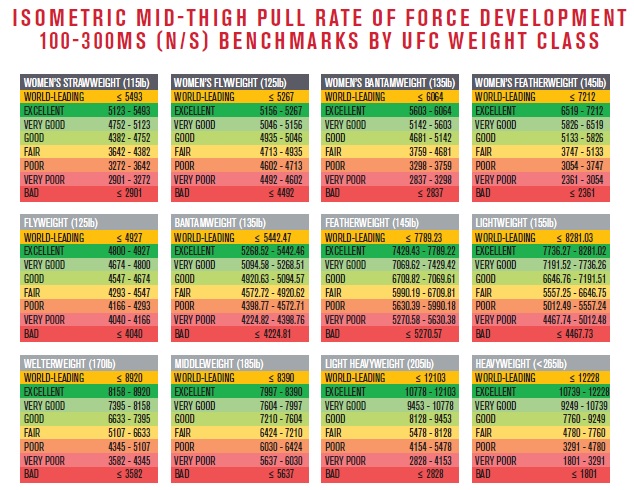
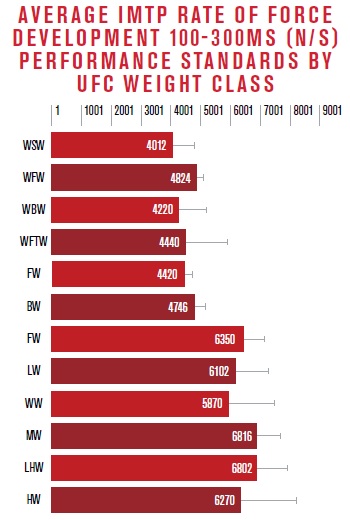
Now, very few of you will have access to equipment and people that can perform this test. However, recent research in 2018 has shown the IMTP has very strong correlations with the 1RM deadlift [2].
While the numbers presented are relative to bodyweight, a deadlift relative strength will be much lower due to the type of contraction and the range of motion. I good general benchmark for the deadlift is 2.5x body weight.
If you are over that benchmark, congratulations! Now it may be time to spend more time on other strength qualities. If you’re under that benchmark, perhaps it’s time to but a little more focus on improving maximal strength.
Maximum strength figures have also been updated in the new 2021 analysis by the UFC PI. However, we can’t compare the data due to the difference in analysis.
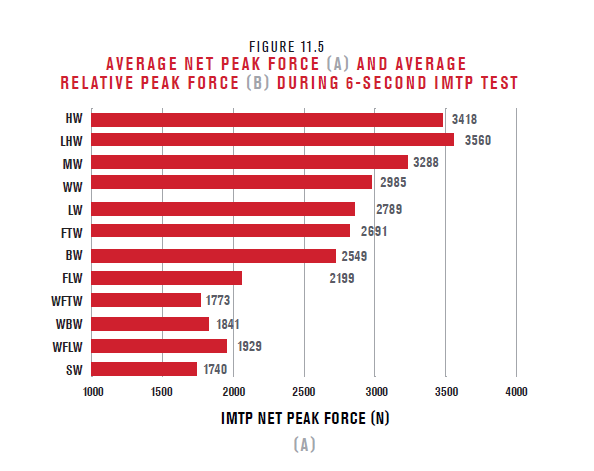
As you can see, peak force values are much lower than the previous analysis. It’s interesting as the new graph displays peak force for the whole test (6 seconds) whereas the 2018 analysis shows peak force between 100-300ms and is still much greater.
This could be down to a completely different cohort of fighters being tested or it could be because of different testing methods.
We know that the UFC Performance Institute is not only in Nevada anymore. The UFC PI in Shanghai has also been testing fighters and one is opening in Mexico.
Dynamic Strength Index
If you’re lucky enough to be able to have access to these pieces of equipment, you can calculate the Dynamic Strength Index (DSI).
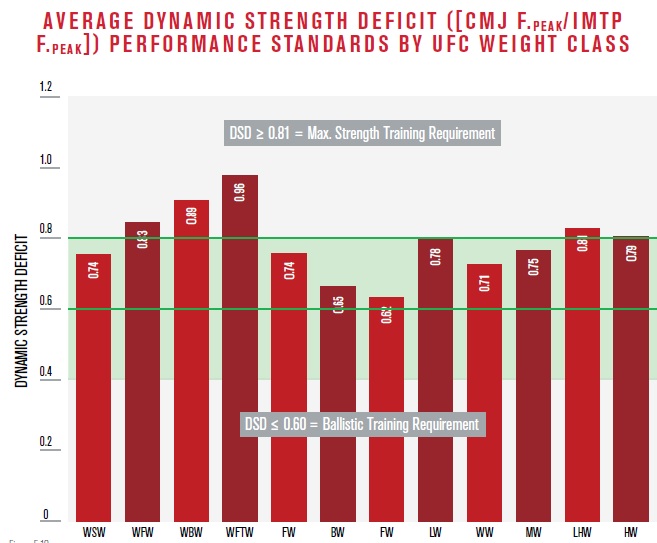
It’s simply calculated by the ratio between the peak force during the CMJ and peak force during the IMTP. This information will tell you whether or not you should focus on ballistic type training (i.e. jumps) or on maximal strength training (e.g. heavy squats or deadlifts).
Taking the data from these fighters, if you’re a female fighter it would be wise to place a strong emphasis on maximal strength training especially if you don’t have a background in lifting weights.
As a male fighter, if you’re unable to test this and you have a large background in lifting weights, then you likely should emphasis the ballistic training. If you don’t have a background in lifting, then focusing on some maximal strength will likely benefit you.
What Should You Do Next?
Because many of the tests conducted in the UFCPI book are difficult to perform for the average fighter, having an experienced strength & conditioning coach perform these tests on you can help see where you stack up against the pros. In doing so, you’re able to identify and attack your weaknesses to overhaul your fight performance.
If you are going it alone, then get familiar with the My Jump 2 app and use the general rule of being able to deadlift 2.5x your body weight. Being strong for MMA is more than just lifting heavy, work on your reactive and elastic abilities to become a well-rounded athlete.
References
3. UFCPI “A Cross-Sectional Performance Analysis And Projection Of The UFC Athlete”

